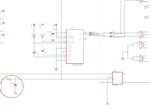martin_t
Newbie level 6
- Joined
- Dec 23, 2013
- Messages
- 11
- Helped
- 0
- Reputation
- 0
- Reaction score
- 0
- Trophy points
- 1
- Location
- Buenos Aires, Argentina
- Activity points
- 113
Hi all.
I've been doing some tests with a circuit based around a cd14538.
In the datasheet it says it can be triggered by either positive going edge or negative going edge.
In this situation I need it to be trigered by the second option (negative).
During breadboarding I noticed that the IC triggered with positive edges despite the fact that it was configured the other way. Could it be because of the wires' inductance causing some sort of oscillation?
I decided to put a low pass at the trigger input (circled in red) to smooth the signal a little and it worked, but I wanted to ask if anyone had some experience with this IC and faced the same situation.

Any comment is welcome.
Thanks very much.
Martín
I've been doing some tests with a circuit based around a cd14538.
In the datasheet it says it can be triggered by either positive going edge or negative going edge.
In this situation I need it to be trigered by the second option (negative).
During breadboarding I noticed that the IC triggered with positive edges despite the fact that it was configured the other way. Could it be because of the wires' inductance causing some sort of oscillation?
I decided to put a low pass at the trigger input (circled in red) to smooth the signal a little and it worked, but I wanted to ask if anyone had some experience with this IC and faced the same situation.

Any comment is welcome.
Thanks very much.
Martín